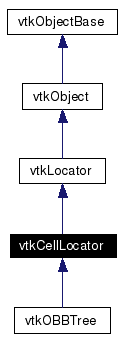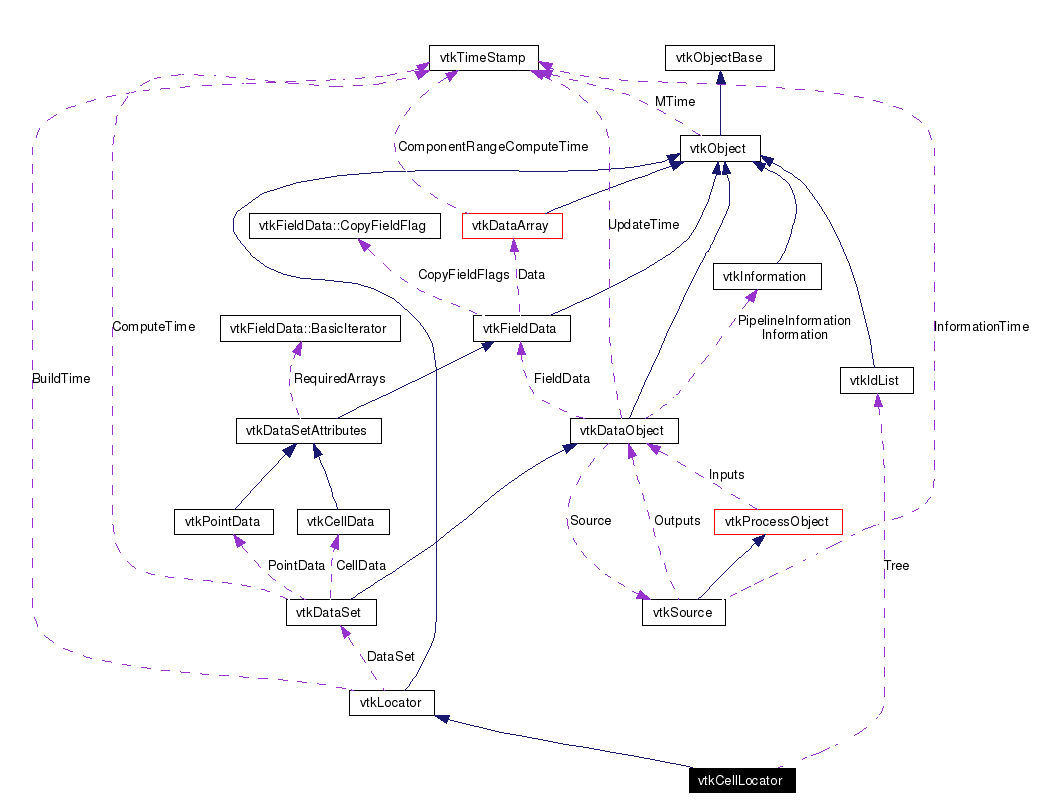
#include <vtkCellLocator.h>
Inheritance diagram for vtkCellLocator:


vtkCellLocator is a spatial search object to quickly locate cells in 3D. vtkCellLocator uses a uniform-level octree subdivision, where each octant (an octant is also referred to as a bucket) carries an indication of whether it is empty or not, and each leaf octant carries a list of the cells inside of it. (An octant is not empty if it has one or more cells inside of it.) Typical operations are intersection with a line to return candidate cells, or intersection with another vtkCellLocator to return candidate cells.
Definition at line 51 of file vtkCellLocator.h.
| virtual void | SetNumberOfCellsPerBucket (int) |
| virtual int | GetNumberOfCellsPerBucket () |
| static vtkCellLocator * | New () |
Public Types | |
| typedef vtkLocator | Superclass |
Public Member Functions | |
| virtual const char * | GetClassName () |
| virtual int | IsA (const char *type) |
| void | PrintSelf (ostream &os, vtkIndent indent) |
| virtual vtkIdList * | GetCells (int bucket) |
| virtual void | SetCacheCellBounds (int) |
| virtual int | GetCacheCellBounds () |
| virtual void | CacheCellBoundsOn () |
| virtual void | CacheCellBoundsOff () |
| virtual int | IntersectWithLine (double a0[3], double a1[3], double tol, double &t, double x[3], double pcoords[3], int &subId) |
| virtual int | IntersectWithLine (double a0[3], double a1[3], double tol, double &t, double x[3], double pcoords[3], int &subId, vtkIdType &cellId) |
| virtual int | IntersectWithLine (double a0[3], double a1[3], double tol, double &t, double x[3], double pcoords[3], int &subId, vtkIdType &cellId, vtkGenericCell *cell) |
| void | FindClosestPoint (double x[3], double closestPoint[3], vtkIdType &cellId, int &subId, double &dist2) |
| void | FindClosestPoint (double x[3], double closestPoint[3], vtkGenericCell *cell, vtkIdType &cellId, int &subId, double &dist2) |
| int | FindClosestPointWithinRadius (double x[3], double radius, double closestPoint[3], vtkIdType &cellId, int &subId, double &dist2) |
| int | FindClosestPointWithinRadius (double x[3], double radius, double closestPoint[3], vtkGenericCell *cell, vtkIdType &cellId, int &subId, double &dist2) |
| int | FindClosestPointWithinRadius (double x[3], double radius, double closestPoint[3], vtkGenericCell *cell, vtkIdType &cellId, int &subId, double &dist2, int &inside) |
| virtual int | GetNumberOfBuckets (void) |
| void | FreeSearchStructure () |
| void | BuildLocator () |
| void | GenerateRepresentation (int level, vtkPolyData *pd) |
Static Public Member Functions | |
| static int | IsTypeOf (const char *type) |
| static vtkCellLocator * | SafeDownCast (vtkObject *o) |
Protected Member Functions | |
| vtkCellLocator () | |
| ~vtkCellLocator () | |
| void | GetBucketNeighbors (int ijk[3], int ndivs, int level) |
| void | GetOverlappingBuckets (double x[3], int ijk[3], double dist, int prevMinLevel[3], int prevMaxLevel[3]) |
| void | ClearCellHasBeenVisited () |
| void | ClearCellHasBeenVisited (int id) |
| double | Distance2ToBucket (double x[3], int nei[3]) |
| double | Distance2ToBounds (double x[3], double bounds[6]) |
| void | MarkParents (void *, int, int, int, int, int) |
| void | GetChildren (int idx, int level, int children[8]) |
| int | GenerateIndex (int offset, int numDivs, int i, int j, int k, vtkIdType &idx) |
| void | GenerateFace (int face, int numDivs, int i, int j, int k, vtkPoints *pts, vtkCellArray *polys) |
| void | ComputeOctantBounds (int i, int j, int k) |
| int | IsInOctantBounds (double x[3]) |
Protected Attributes | |
| int | NumberOfCellsPerBucket |
| int | NumberOfOctants |
| double | Bounds [6] |
| int | NumberOfParents |
| double | H [3] |
| int | NumberOfDivisions |
| vtkIdList ** | Tree |
| vtkNeighborCells * | Buckets |
| unsigned char * | CellHasBeenVisited |
| unsigned char | QueryNumber |
| int | CacheCellBounds |
| double(* | CellBounds )[6] |
| double | OctantBounds [6] |
|
|
Reimplemented from vtkLocator. Reimplemented in vtkOBBTree. Definition at line 54 of file vtkCellLocator.h. |
|
|
|
|
|
|
|
|
Reimplemented from vtkLocator. Reimplemented in vtkOBBTree. |
|
|
Return 1 if this class type is the same type of (or a subclass of) the named class. Returns 0 otherwise. This method works in combination with vtkTypeRevisionMacro found in vtkSetGet.h. Reimplemented from vtkLocator. Reimplemented in vtkOBBTree. |
|
|
Return 1 if this class is the same type of (or a subclass of) the named class. Returns 0 otherwise. This method works in combination with vtkTypeRevisionMacro found in vtkSetGet.h. Reimplemented from vtkLocator. Reimplemented in vtkOBBTree. |
|
|
Reimplemented from vtkLocator. Reimplemented in vtkOBBTree. |
|
||||||||||||
|
Methods invoked by print to print information about the object including superclasses. Typically not called by the user (use Print() instead) but used in the hierarchical print process to combine the output of several classes. Reimplemented from vtkLocator. Reimplemented in vtkOBBTree. |
|
|
Construct with automatic computation of divisions, averaging 25 cells per bucket. Reimplemented from vtkObject. Reimplemented in vtkOBBTree. |
|
|
Specify the average number of cells in each octant. |
|
|
Specify the average number of cells in each octant. |
|
|
Boolean controls whether the bounds of each cell are computed only once and then saved. Should be 10 to 20% faster if repeatedly calling any of the FindClosestPoint routines and the extra memory won't cause disk caching (24 extra bytes per cell are required to save the bounds). |
|
|
Boolean controls whether the bounds of each cell are computed only once and then saved. Should be 10 to 20% faster if repeatedly calling any of the FindClosestPoint routines and the extra memory won't cause disk caching (24 extra bytes per cell are required to save the bounds). |
|
|
Boolean controls whether the bounds of each cell are computed only once and then saved. Should be 10 to 20% faster if repeatedly calling any of the FindClosestPoint routines and the extra memory won't cause disk caching (24 extra bytes per cell are required to save the bounds). |
|
|
Boolean controls whether the bounds of each cell are computed only once and then saved. Should be 10 to 20% faster if repeatedly calling any of the FindClosestPoint routines and the extra memory won't cause disk caching (24 extra bytes per cell are required to save the bounds). |
|
||||||||||||||||||||||||||||||||
|
Return intersection point (if any) of finite line with cells contained in cell locator. Reimplemented in vtkOBBTree. |
|
||||||||||||||||||||||||||||||||||||
|
Return intersection point (if any) AND the cell which was intersected by the finite line. Reimplemented in vtkOBBTree. |
|
||||||||||||||||||||||||||||||||||||||||
|
Return intersection point (if any) AND the cell which was intersected by the finite line. The cell is returned as a cell id and as a generic cell. Reimplemented in vtkOBBTree. |
|
||||||||||||||||||||||||
|
Return the closest point and the cell which is closest to the point x. The closest point is somewhere on a cell, it need not be one of the vertices of the cell. |
|
||||||||||||||||||||||||||||
|
Return the closest point and the cell which is closest to the point x. The closest point is somewhere on a cell, it need not be one of the vertices of the cell. This version takes in a vtkGenericCell to avoid allocating and deallocating the cell. This is much faster than the version which does not take a *cell, especially when this function is called many times in a row such as by a for loop, where the allocation and deallocation can be done only once outside the for loop. If a cell is found, "cell" contains the points and ptIds for the cell "cellId" upon exit. |
|
||||||||||||||||||||||||||||
|
Return the closest point within a specified radius and the cell which is closest to the point x. The closest point is somewhere on a cell, it need not be one of the vertices of the cell. This method returns 1 if a point is found within the specified radius. If there are no cells within the specified radius, the method returns 0 and the values of closestPoint, cellId, subId, and dist2 are undefined. |
|
||||||||||||||||||||||||||||||||
|
Return the closest point within a specified radius and the cell which is closest to the point x. The closest point is somewhere on a cell, it need not be one of the vertices of the cell. This method returns 1 if a point is found within the specified radius. If there are no cells within the specified radius, the method returns 0 and the values of closestPoint, cellId, subId, and dist2 are undefined. This version takes in a vtkGenericCell to avoid allocating and deallocating the cell. This is much faster than the version which does not take a *cell, especially when this function is called many times in a row such as by a for loop, where the allocation and deallocation can be done only once outside the for loop. If a closest point is found, "cell" contains the points and ptIds for the cell "cellId" upon exit. |
|
||||||||||||||||||||||||||||||||||||
|
Return the closest point within a specified radius and the cell which is closest to the point x. The closest point is somewhere on a cell, it need not be one of the vertices of the cell. This method returns 1 if a point is found within the specified radius. If there are no cells within the specified radius, the method returns 0 and the values of closestPoint, cellId, subId, and dist2 are undefined. This version takes in a vtkGenericCell to avoid allocating and deallocating the cell. This is much faster than the version which does not take a *cell, especially when this function is called many times in a row such as by a for loop, where the allocation and dealloction can be done only once outside the for loop. If a closest point is found, "cell" contains the points and ptIds for the cell "cellId" upon exit. If a closest point is found, inside returns the return value of the EvaluatePosition call to the closest cell; inside(=1) or outside(=0). |
|
|
Get the cells in a particular bucket. |
|
|
Return number of buckets available. Insure that the locator has been built before attempting to access buckets (octants). |
|
|
Satisfy vtkLocator abstract interface. Implements vtkLocator. Reimplemented in vtkOBBTree. |
|
|
Return number of buckets available. Insure that the locator has been built before attempting to access buckets (octants). Implements vtkLocator. Reimplemented in vtkOBBTree. |
|
||||||||||||
|
Return number of buckets available. Insure that the locator has been built before attempting to access buckets (octants). Implements vtkLocator. Reimplemented in vtkOBBTree. |
|
||||||||||||||||
|
|
|
||||||||||||||||||||||||
|
|
|
|
|
|
|
|
|
||||||||||||
|
|
|
||||||||||||
|
|
|
||||||||||||||||||||||||||||
|
|
|
||||||||||||||||
|
|
|
||||||||||||||||||||||||||||
|
|
|
||||||||||||||||||||||||||||||||
|
|
|
||||||||||||||||
|
|
|
|
Definition at line 234 of file vtkCellLocator.h. |
|
|
Definition at line 209 of file vtkCellLocator.h. |
|
|
Definition at line 210 of file vtkCellLocator.h. |
|
|
Definition at line 211 of file vtkCellLocator.h. |
|
|
Definition at line 212 of file vtkCellLocator.h. |
|
|
Definition at line 213 of file vtkCellLocator.h. |
|
|
Definition at line 214 of file vtkCellLocator.h. |
|
|
Reimplemented in vtkOBBTree. Definition at line 215 of file vtkCellLocator.h. |
|
|
Definition at line 224 of file vtkCellLocator.h. |
|
|
Definition at line 225 of file vtkCellLocator.h. |
|
|
Definition at line 226 of file vtkCellLocator.h. |
|
|
Definition at line 227 of file vtkCellLocator.h. |
|
|
Definition at line 229 of file vtkCellLocator.h. |
|
|
Definition at line 233 of file vtkCellLocator.h. |
 1.4.3-20050530
1.4.3-20050530